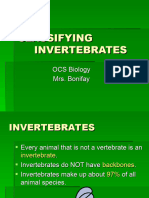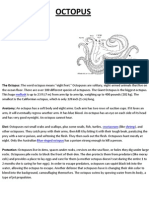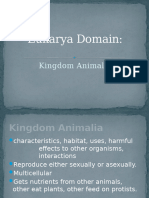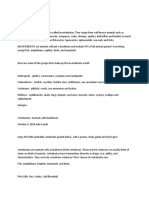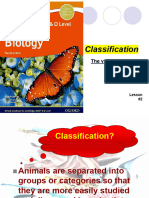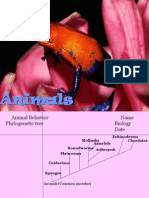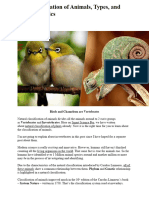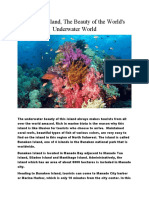Summary
Summary
Uploaded by
gadiconstanceCopyright:
Available Formats
Summary
Summary
Uploaded by
gadiconstanceCopyright
Available Formats
Share this document
Did you find this document useful?
Is this content inappropriate?
Copyright:
Available Formats
Summary
Summary
Uploaded by
gadiconstanceCopyright:
Available Formats
Summary
Animal Groups
Vertebrates and Invertebrates
Almost all animals fall into one of two groups. Adult vertebrates have a spinal column, or backbone, running the
length of the body; invertebrates do not. Vertebrates are often larger and have more complex bodies than
invertebrates. However, there are many more invertebrates than vertebrates.
Vertebrates
Fish breathe through gills, and live in water; most are cold-blooded and lay eggs (although sharks give birth
to live young).
Amphibians are cold-blooded and live both on land (breathing with lungs) and in water (breathing through
gills) at different times. Three types of amphibians are frogs and toads, salamanders, and caecilians.
Caecilians are primitive amphibians that resemble earthworms. They are found in the tropics.
Reptiles are cold-blooded and breathe with lungs. They have scales, and most lay eggs. Reptiles include
snakes, turtles and tortoises, crocodiles and alligators, and lizards. Dinosaurs were reptiles, although some
scientists believe that some were warm blooded.
Birds are warm-blooded animals with feathers and wings. They lay eggs, and most can fly (although many,
including penguins and ostriches, cannot).
Mammals are warm-blooded, and are nourished by their mothers' milk; most are born live (however, the
platypus lays eggs). Most mammals also have body hair.
Invertebrates
Sponges are the most primitive of animal groups. They live in water (usually saltwater), are sessile (do not
move from place to place), and filter tiny organisms out of the water for food.
Coelenterates are also very primitive. Their mouths, which take in food and get rid of waste, are surrounded
by stinging tentacles. Some coelenterates are jellyfish, corals, and sea anemones.
Echinoderms include starfish, sea urchins, and sea cucumbers. They live in seawater and have external
skeletons.
Worms come in many varieties and live in all sorts of habitats — from the bottom of the ocean to the inside
of other animals. They include flatworms (flukes), roundworms (hookworms), segmented worms
(earthworms), and rotifers (philodina).
Mollusks are soft-bodied animals, which often live in hard shells. They include snails, slugs, octopus, squid,
mussels, oysters, clams, scallops, chitons, and cuttlefish. Mollusks are the second-largest group of
invertebrates, with 50,000 living species.
Arthropods are the largest and most diverse of all animal groups. They have segmented bodies supported
by a hard external skeleton (or exoskeleton). Arthropods include insects, arachnids (spiders and their
relatives), centipedes, millipedes, and crustaceans like crabs, lobsters, and shrimp.
You might also like
- Classifying InvertebratesDocument9 pagesClassifying InvertebratesKurt EmmañuelNo ratings yet
- Project ScienceDocument16 pagesProject Scienceangelica nicole san juanNo ratings yet
- Reporters: Maun, Maja Mariella Gonzales, Alessy Joy Cortez, KateDocument34 pagesReporters: Maun, Maja Mariella Gonzales, Alessy Joy Cortez, KateKate CortezNo ratings yet
- Science Is Awesome!: 101 Incredible Things Every Kid Should KnowFrom EverandScience Is Awesome!: 101 Incredible Things Every Kid Should KnowNo ratings yet
- InvertebratesDocument55 pagesInvertebratesNajibah CasimNo ratings yet
- Vertebrates: Paedophryne AmauensisDocument5 pagesVertebrates: Paedophryne AmauensisBochai BagolorNo ratings yet
- Invertebrate DefinitionDocument8 pagesInvertebrate Definitionashley brownNo ratings yet
- AnimalsDocument43 pagesAnimalsGina ZanneNo ratings yet
- invertibraeDocument10 pagesinvertibraemknightNo ratings yet
- Vertebrates Vs InvertebratesDocument2 pagesVertebrates Vs InvertebratesEaint Pyae KhinNo ratings yet
- CLASSIFYING InvertebratesDocument19 pagesCLASSIFYING Invertebratescristian gonzalezNo ratings yet
- Invertebrate Animals (6TH Grade Science)Document47 pagesInvertebrate Animals (6TH Grade Science)anonymousNo ratings yet
- Kingdom Classification 2Document6 pagesKingdom Classification 2frozenkiara22No ratings yet
- Classifying Animals into Vertebrates and Invertebrates - Animal Book for 8 Year Olds | Children's Animal BooksFrom EverandClassifying Animals into Vertebrates and Invertebrates - Animal Book for 8 Year Olds | Children's Animal BooksNo ratings yet
- Classification of AnimalsDocument47 pagesClassification of AnimalsReylen MaderazoNo ratings yet
- Invertebrates AntonetteDocument27 pagesInvertebrates Antonetteduganirene1No ratings yet
- VertebratesDocument8 pagesVertebratesfeya ayefNo ratings yet
- Marine AnimalsDocument58 pagesMarine AnimalsSofia Mechel AdraNo ratings yet
- Phylum ChordataDocument25 pagesPhylum ChordataNicole100% (1)
- InvertebratesDocument21 pagesInvertebratesJohann FaustNo ratings yet
- Animal Kingdom ClassificationDocument20 pagesAnimal Kingdom Classificationsarvesh672No ratings yet
- WWGC Reptiles NotesDocument11 pagesWWGC Reptiles NotesNirek MakenNo ratings yet
- ProjectDocument5 pagesProjectAbid ShaikhNo ratings yet
- Group 3: Kingdom AnimaliaDocument23 pagesGroup 3: Kingdom AnimaliabrettNo ratings yet
- Animals: Cells Eukaryotic CellsDocument17 pagesAnimals: Cells Eukaryotic CellsFallianda YandaNo ratings yet
- Vertebrate ClassificationDocument5 pagesVertebrate Classificationaneesh sebastianNo ratings yet
- HerpetolgyDocument67 pagesHerpetolgybelgieabebaw09No ratings yet
- AnimaliaDocument46 pagesAnimaliaChristine FidelNo ratings yet
- INVERTEBRATE AND VertebratesDocument3 pagesINVERTEBRATE AND Vertebratesian rex desolocNo ratings yet
- Invertebrates Display PostersDocument6 pagesInvertebrates Display PostersEunice HuangNo ratings yet
- 13 VertebrateDocument43 pages13 VertebrateAmelia Puji LestariNo ratings yet
- Elden John B. Efren Teacher Belson D. Beltran Section AmethystDocument43 pagesElden John B. Efren Teacher Belson D. Beltran Section AmethystMae Angelie TuñacaoNo ratings yet
- Bio 111-1Document13 pagesBio 111-1efep478No ratings yet
- ClassificationDocument40 pagesClassificationSajed- JRNo ratings yet
- 14 BIOL 1201-MollusksDocument22 pages14 BIOL 1201-Molluskslikaswecelestine9No ratings yet
- REVIEW Year 6 1st T PDFDocument25 pagesREVIEW Year 6 1st T PDFizaNo ratings yet
- Al Jeanne RomanoDocument24 pagesAl Jeanne Romanoapi-249379895No ratings yet
- Comparative Vertebrate AnatomyDocument5 pagesComparative Vertebrate AnatomyNeha ChoudharyNo ratings yet
- AnimalphylaparagraphsDocument3 pagesAnimalphylaparagraphsapi-272770403No ratings yet
- Vertebrates and InvertebratesDocument15 pagesVertebrates and InvertebratesNurul FarihinNo ratings yet
- Basic Types of Animals and Their CharacteristicsDocument5 pagesBasic Types of Animals and Their CharacteristicsAurea Jasmine DacuycuyNo ratings yet
- ArthropodsDocument2 pagesArthropodsAnnEviteNo ratings yet
- The Phylum Echinodermata: A. AsteroideaDocument10 pagesThe Phylum Echinodermata: A. AsteroideaCindy RahmahNo ratings yet
- Kingdom Animalia - Ernesto MarinDocument26 pagesKingdom Animalia - Ernesto MarinsanazhNo ratings yet
- Diversity of LifeDocument7 pagesDiversity of LifeSai MuttavarapuNo ratings yet
- Science 2nd Summative TestDocument20 pagesScience 2nd Summative Testmary alyssa dayaoNo ratings yet
- Aquarium ClassificationDocument10 pagesAquarium ClassificationPrincess DarishanaNo ratings yet
- Vertebrate DiversityDocument14 pagesVertebrate DiversityKacang PeasNo ratings yet
- Turtle - InggrisDocument2 pagesTurtle - InggrisHermawan SetiawanNo ratings yet
- Animal Diversity - The Kingdom Animalia 1. Phylum Porifera - SpongesDocument6 pagesAnimal Diversity - The Kingdom Animalia 1. Phylum Porifera - SpongesSamantha Dasmariñas MagaanNo ratings yet
- Phylum AnnelidaDocument6 pagesPhylum AnnelidaRechelle CabagingNo ratings yet
- Animal Kingdom ComplexDocument62 pagesAnimal Kingdom Complexbobbie66No ratings yet
- PHYLUMSDocument6 pagesPHYLUMSJanelle RedobladoNo ratings yet
- Classification of Living Thingsbiologygrade 9b Myp 4 4emesecond Term2023 20241713261495Document12 pagesClassification of Living Thingsbiologygrade 9b Myp 4 4emesecond Term2023 20241713261495decampostelma1No ratings yet
- The Animal KingdomDocument17 pagesThe Animal KingdomJimmy Alvarez Romero100% (1)
- Animals NoteDocument23 pagesAnimals NoteMike LuchNo ratings yet
- TERRESTRIAL ADAPTATIONS IN ReptilesDocument33 pagesTERRESTRIAL ADAPTATIONS IN ReptilesErin Martinez75% (12)
- Invertebrates: Group of Animals That Do Not Have BackbonesDocument32 pagesInvertebrates: Group of Animals That Do Not Have BackbonesRey Gozarin SilvestreNo ratings yet
- ArthropodsDocument8 pagesArthropodsLearn To EarnNo ratings yet
- Evolution of ReptilesDocument11 pagesEvolution of ReptilesManoj Kumar UpadhyayNo ratings yet
- Descriptive Text Bunaken IslandDocument3 pagesDescriptive Text Bunaken IslandNoflin WenasNo ratings yet
- A Level GASEOUS EXCHANGEDocument20 pagesA Level GASEOUS EXCHANGEonyangaismail12No ratings yet
- Minimal Impact Sea KayakingDocument17 pagesMinimal Impact Sea KayakingChrisNo ratings yet
- I Want A MonkeyDocument5 pagesI Want A MonkeyPetrache RoxanaNo ratings yet
- Soal Flyer 2Document7 pagesSoal Flyer 2tpqnurulhikmah255No ratings yet
- Stages in The Life Cycle of Organisms: Worksheet in Science IvDocument2 pagesStages in The Life Cycle of Organisms: Worksheet in Science IvAnnabelle Poniente Hertez0% (1)
- 1 Reading Comprehension For Early ReaderDocument22 pages1 Reading Comprehension For Early ReaderConsuelo CabsonNo ratings yet
- Tle Agri 6-Q1-DW17Document5 pagesTle Agri 6-Q1-DW17Genalyn Tambiao Achanzar100% (2)
- MEGALODONDocument5 pagesMEGALODONPatsy Valderrama MoronesNo ratings yet
- Blue Moon Bass-Losin' BluesDocument3 pagesBlue Moon Bass-Losin' BluesSam RizzoNo ratings yet
- Kaasvaachi Ghosht (Turtle Story) - MarathiDocument28 pagesKaasvaachi Ghosht (Turtle Story) - MarathiPratham BooksNo ratings yet
- Assesstment Test Q2 #1 ScienceDocument16 pagesAssesstment Test Q2 #1 ScienceArenas JenNo ratings yet
- Chapter-6-Integument NotesDocument12 pagesChapter-6-Integument NotesWenaNo ratings yet
- Chapter - 2 Fish MongeryDocument10 pagesChapter - 2 Fish MongeryKrishna ChaudharyNo ratings yet
- The Philippine Blue Swimming Crab Management Plan: Department of Agriculture Bureau of Fisheries and Aquatic ResourcesDocument33 pagesThe Philippine Blue Swimming Crab Management Plan: Department of Agriculture Bureau of Fisheries and Aquatic ResourcescjudebetanzorNo ratings yet
- Unique Words - First Flight (Prashant Kirad)Document12 pagesUnique Words - First Flight (Prashant Kirad)laptop889625100% (1)
- DLP in Science (Chemistry and Biology)Document8 pagesDLP in Science (Chemistry and Biology)Ana Rose OcfemiaNo ratings yet
- Jurnal: Karakteristik Fisik Pakan Ikan Apung Non-Ekstrusi Yang Dibuat Melalui Fermentasi Rhizopus OryzaeDocument9 pagesJurnal: Karakteristik Fisik Pakan Ikan Apung Non-Ekstrusi Yang Dibuat Melalui Fermentasi Rhizopus Oryzaezuraida_ziedaNo ratings yet
- Aimcat 2219Document29 pagesAimcat 2219Aditya ChoudharyNo ratings yet
- Aquarium Observation LabDocument4 pagesAquarium Observation LabIsaiah BoussicautNo ratings yet
- 75 Fantasy Adventure HooksDocument9 pages75 Fantasy Adventure HooksGabriel LopezNo ratings yet
- MAP 4 Reading Level 3 - Quiz 1Document27 pagesMAP 4 Reading Level 3 - Quiz 1Chris KongNo ratings yet
- Pre-A1 Week 19-Lets Help Endangered Animals EdwinDocument6 pagesPre-A1 Week 19-Lets Help Endangered Animals EdwinJhon brayan Espinosa salazarNo ratings yet
- Dishonored ArchiveDocument1,880 pagesDishonored ArchivegunterNo ratings yet
- Raz Lo12 Magicmigration PBDocument5 pagesRaz Lo12 Magicmigration PBegegnegergeNo ratings yet
- Random Kaiju CreatorDocument3 pagesRandom Kaiju CreatorKeon KobraNo ratings yet
- 2009 Fisheries Profile PhilippinesDocument36 pages2009 Fisheries Profile Philippinesijnt_upvNo ratings yet
- Y5 Unit 3 WorksheetsDocument32 pagesY5 Unit 3 WorksheetsRamathevi KuppanNo ratings yet
- Group 1 - Laboratory 3 1Document49 pagesGroup 1 - Laboratory 3 1J.A. LauronNo ratings yet
- G4 English Reading Comprehension 548Document2 pagesG4 English Reading Comprehension 548kumaravelm6No ratings yet










